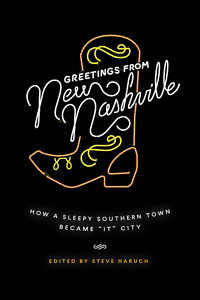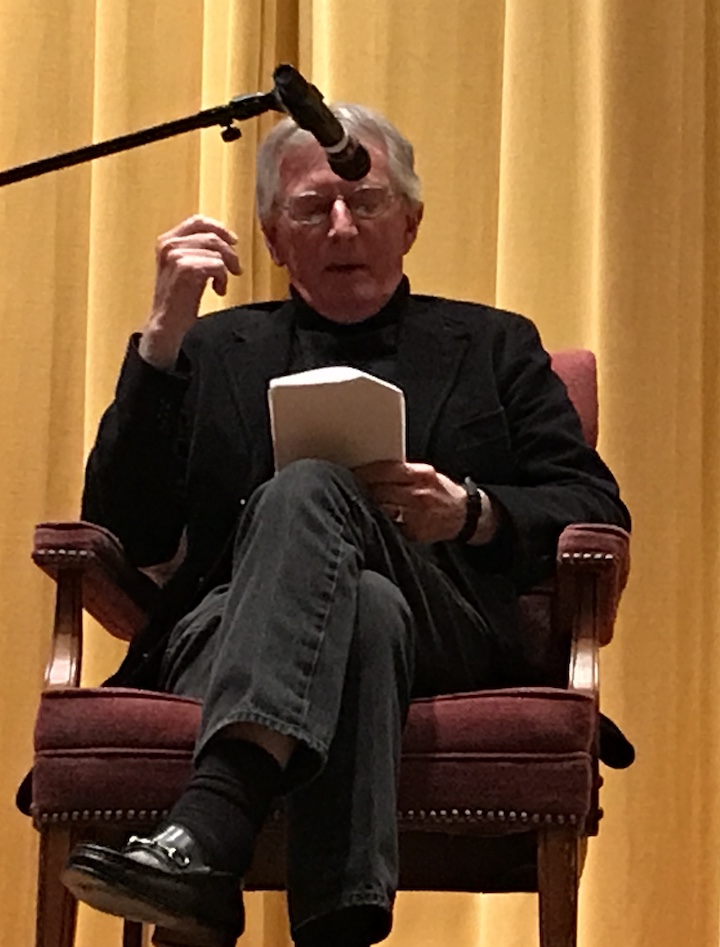1998
Book Excerpt: Greetings from New Nashville
“It’s hard to pinpoint the exact moment the sleepy town of Nashville became a real city, but I’ll go with 1998 — the year the NHL Nashville Predators and NFL Houston Oilers (now the Tennessee Titans) moved here,” the singer and songwriter Marshall Chapman writes in a 2011 story for W magazine. “Suddenly everything exploded. You’d look out over the city, and all you’d see were construction cranes.”

Like all narrative starting points, 1998 is to some extent arbitrary. But Chapman reminds us that what is old is new again — the construction cranes are back, piercing the sky in every direction, their silhouettes now emblazoned half-jokingly on everything from rock show flyers to public radio station pledge-drive socks. The starting point isn’t random, either.
1998 is the year the Owen Bradley dies. As much as any artist and producer, Bradley helped define the Nashville Sound, and Music Row was more or less built around the Quonset Hut Studio he operated with his brother Harold on 16th Avenue South where Patsy Cline, Red Foley, Brenda Lee, Marty Robbins, Sonny James, and countless others recorded. Still, as much as the Nashville Sound is now synonymous with what we now might call classic country music, it was a conscious departure from the folksy Bristol sessions that birthed the genre. “Now we’ve cut out the fiddle and steel guitar and added choruses to country music,” Bradley once said. “But it can’t stop there. It always has to keep developing to keep fresh.”
The same year Bradley passes, the advocacy organization Walk Bike Nashville is formed; in coming years it will be at the table for countless discussions around walkable neighborhoods, pedestrian safety, biking infrastructure — the stuff of urban renewal. The Nashville Banner, the afternoon newspaper that shared a building with The Tennessean, ceases operation in February after 122 years.
Garth Brooks, Faith Hill, Tim McGraw, and Dixie Chicks rule the country charts, but it is a banner year for Nashville’s independent music scene. Lucinda Williams’s Car Wheels on a Gravel Road, Duane Jarvis’s Far from Perfect, Kevin Gordon’s Cadillac Jack’s Son, Paul Burch & the WPA Ballclub’s Wire to Wire, and Lambchop’s What Another Man Spills are all released this year. To whatever extent it registers in Nashville at the time, a Detroit band called the White Stripes releases its first single, “Let’s Shake Hands,” in 1998 as well. Jack White will eventually settle in Nashville, establish Third Man Records, and in so doing alter the perception of the city. The honky-tonk revival on Lower Broadway has only recently begun, but already groups like BR549 are breathing new life into a stretch of the city dominated by the coin-operated peep shows and other unsavory goings-on that filled in after the Grand Ole Opry pulled out of the Ryman Auditorium and settled into its new building out near the sprawling Opryland Hotel and Resort.
It is also the year that a 25-foot-tall statue of Nathan Bedford Forrest — slave owner, early leader of the Ku Klux Klan, and Confederate general whose troops were responsible for the massacre of surrendered black Union soldiers at Fort Pillow — is erected on private property in full view of I-65.
Also in 1998, a years-long effort by the Nashville school board culminates in the end of court-supervised desegregation. The consequences of that will be deep and long lasting.
 Outside of Hank Williams there is arguably no more iconic figure in country music than Johnny Cash. In 1998, fresh off a Grammy win for Best Country Album, the Man in Black appears in full-page ad in Billboard magazine. It’s an older photograph, taken in 1969 at San Quentin Prison. Cash’s mouth is drawn up in a grimace, his lower teeth pressed against his upper lip the way one does when producing the F sound. He holds up his middle finger emphatically. “American Recordings and Johnny Cash would like to acknowledge the Nashville music establishment and country radio for your support,” the caption reads, a reference to the absence of the album from the airwaves Cash once ruled. The sarcasm doesn’t come cheap; producer Rick Rubin reportedly shells out $20,000 for the ad.
Outside of Hank Williams there is arguably no more iconic figure in country music than Johnny Cash. In 1998, fresh off a Grammy win for Best Country Album, the Man in Black appears in full-page ad in Billboard magazine. It’s an older photograph, taken in 1969 at San Quentin Prison. Cash’s mouth is drawn up in a grimace, his lower teeth pressed against his upper lip the way one does when producing the F sound. He holds up his middle finger emphatically. “American Recordings and Johnny Cash would like to acknowledge the Nashville music establishment and country radio for your support,” the caption reads, a reference to the absence of the album from the airwaves Cash once ruled. The sarcasm doesn’t come cheap; producer Rick Rubin reportedly shells out $20,000 for the ad.
On April 15, a little more than a month after Cash’s flipping off of Music Row, a tornado touches down a mile west of where Charlotte Pike meets I-440. It tears across the city, injuring dozens of people, one of whom later dies. It blows out 100 windows in the Tennessee Performing Arts Center and, after crossing the Cumberland River, topples three of the 10 cranes that are on site for the construction of the new NFL stadium. Then it keeps going, through the residential sections of East Nashville.
On that day, as the funnel cloud twists through the neighborhood, Joe Goller huddles inside the walk-in cooler in his restaurant on Eastland Avenue. When he finally emerges, the cooler and a few walls are all that remain of Joe’s Diner. A photograph of then Vice President Al Gore standing amid the rubble, where the front window had once been, subsequently goes the pre-Y2K equivalent of viral. As Kay West would write in the Scene the following year: “Between all the free publicity and a major insurance settlement, it soon became clear to Goller that the tornado had perhaps been the best thing that could have happened to his fledgling business.”
In some ways, this is true of the entire East Side. As Nate Rau writes in the Tennessean on the 20th anniversary of the outbreak: “The popular bars, pizza joints and upscale restaurants came from entrepreneurs who invested in East Nashville after the tornado hit.” Then Mayor Phil Bredesen creates a tornado recovery task force; the American Institute of Architects dispatches an R/UDAT (Regional/Urban Design Assistance Team).
“It is hard to debate the fact that an enormous amount of insurance money came in to assist with what became case-by-case redevelopment,” attorney Mike Jameson tells the Tennessean’s Rau. “That’s not to say it was without heartache. Months passed with tarps on people’s roofs. But, the money eventually did pour in. It’s just hard to debate that the tornado was, if not a turning point, a boost for East Nashville in the long term.”
And it will be the East Side that, in many ways, leads the way in Nashville’s reimagining of itself. This is partly out of necessity; rebuilding means grappling with city codes, and though residents had already begun thinking about and organizing around such things, it means engaging in a real way with planning, zoning, and preservation. But out of the wreckage a new vision of the city rises, a vision of somewhere a little more modern and worldly.

Copyright (c) 2020 by Steve Haruch. Excerpted from the introduction to Greetings from New Nashville, forthcoming from Vanderbilt University Press in October 2020. Reprinted with permission. All rights reserved. Steve Haruch is a writer and filmmaker whose work has appeared in the Nashville Scene, The New York Times, NPR’s Code Switch, The Guardian, and elsewhere. He is currently producing a documentary film about the history of college radio.

